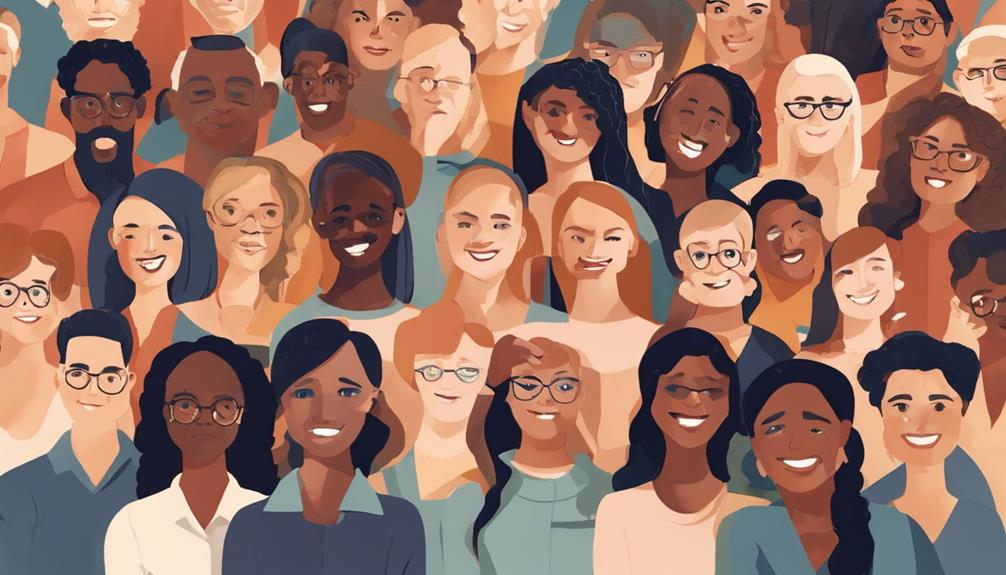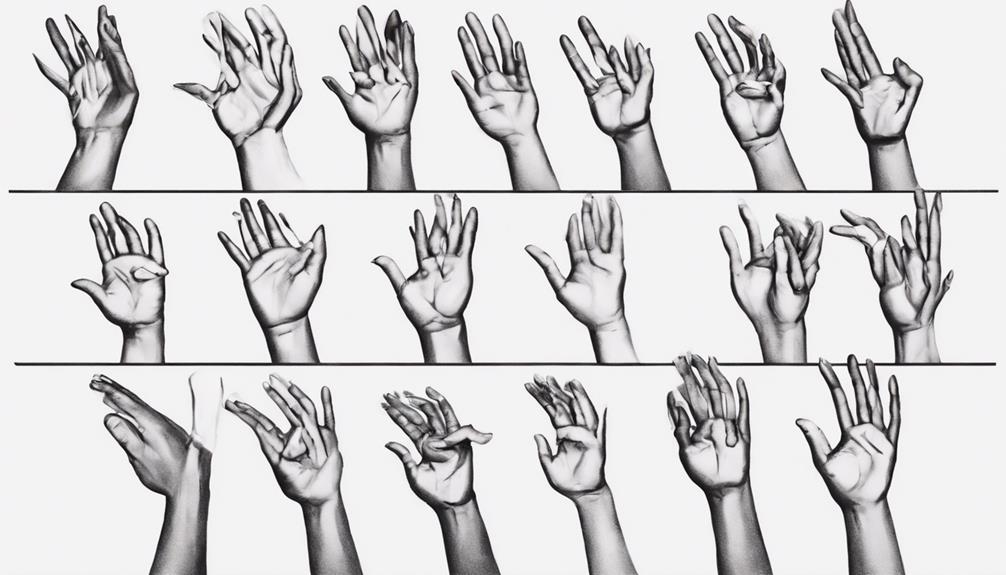Stepping into the world of sign language, Open Sign Language shines brightly as a symbol of innovation in the digital era. It presents a new outlook on how we view and interact with this special mode of communication.
By embracing technology and modern tools, Open Sign Language paves the way for a new era of accessibility and learning. But how does this contemporary approach differ from the traditional roots of sign language that have been deeply embedded in culture and history?
Let's explore the nuances and implications that set Open Sign Language apart, reshaping the landscape of communication for all.
Key Takeaways
- Open Sign Language prioritizes inclusivity, flexibility, and creativity in communication.
- Syntax variations in Open Sign Language allow for expressive and diverse message delivery.
- Cultural differences are embraced in Open Sign Language to enhance individuality and acceptance.
- Open Sign Language fosters collaboration, accessibility, and innovation in sign language education and evolution.
Origins and Evolution
In exploring the origins and evolution of Open Sign Language, we witness a significant departure from traditional sign language practices towards a more inclusive and adaptable approach to communication. Open Sign Language embraces the diversity of sign languages and variants due to regional, cultural, and individual differences, recognizing the importance of accommodating various signing preferences.
Unlike traditional sign languages that may adhere to specific rules and structures, Open Sign Language promotes flexibility and creativity in communication by incorporating different sign language variations and gestures to meet the needs of a diverse community. This approach allows for the development of new signs and expressions that better reflect individual and communal experiences, fostering a more dynamic and evolving sign language environment.
The visual nature of sign languages is enhanced through the innovative practices of Open Sign Language, encouraging a fluid and inclusive communication style that values diversity and individual expression.
Key Characteristics of Open Sign Language

Exploring the key characteristics of Open Sign Language reveals a fundamental shift towards transparency, accessibility, and inclusivity in communication practices for both deaf and hearing individuals. Open Sign Language emphasizes the use of clear and easily understandable signs, drawing inspiration from Quebec Sign Language, ASL signs, and baby sign language. These signs are intuitive, straightforward, and inclusive, aiming to break down communication barriers and promote universal understanding.
One of the key focuses of Open Sign Language is its simplicity and clarity, making it easier for a diverse range of users to learn and understand. This approach benefits not only deaf children but also hearing individuals seeking to communicate effectively with the deaf community. By using signs that are widely recognized and easily comprehensible, Open Sign Language fosters a more inclusive and accessible communication environment. The principles of Open Sign Language prioritize transparent signs that enhance communication for all parties involved, promoting a more inclusive and understanding society.
Grammar and Syntax Variances
With its allowance for more flexible word order compared to traditional sign languages, Open Sign Language introduces a dynamic shift in grammar and syntax variances that enhance communicative expressiveness and adaptability. Traditional sign languages often adhere to a subject-object-verb (SOV) structure, whereas Open Sign Language permits subject-verb-object (SVO) arrangements, offering a more versatile approach to sentence construction. The grammar rules in Open Sign Language are designed to be adaptable, catering to diverse communication contexts and needs. Syntax variations in Open Sign Language play a crucial role in enhancing expressiveness and creativity in conveying messages effectively.
| Grammar | Syntax | Traditional Sign Languages |
|---|---|---|
| Adaptable | Enhancing | Subject-Object-Verb (SOV) |
| Flexible | Expressive | Fixed word order |
| Dynamic | Creativity | Less room for variation |
| Versatile | Communication | Structured syntax |
| Innovative | Message | Conventional grammar |
Cultural Implications and Differences

Transitioning from the discussion on grammar and syntax variances in Open Sign Language, the cultural implications and differences of this innovative approach shed light on its inclusive nature and impact within deaf communities. Open Sign Language, unlike traditional sign languages such as American Sign Language, promotes diversity, acceptance, and innovation by embracing different signing techniques and perspectives. It emphasizes fluidity, adaptability, and inclusivity, allowing for a more dynamic exchange of ideas. This cultural shift encourages creativity and individuality in communication styles, enhancing the overall expressive capacity of sign language.
Deaf people benefit from this approach as it provides them with a platform to express themselves more freely and authentically. By welcoming variations and personal adaptations, Open Sign Language fosters a sense of belonging and empowerment within the deaf community. The cultural implications of this inclusive signing method extend beyond communication, influencing social dynamics and community engagement positively. Embracing Open Sign Language signifies a step towards a more inclusive and accepting society for deaf individuals.
Adoption and Future Impact
Open Sign Language's adoption and future impact on global communication and sign language education are key focal points in understanding its potential transformative influence within deaf communities. By promoting the sharing of sign language resources through open access platforms, Open Sign Language initiatives facilitate collaboration among sign language users, educators, and researchers worldwide. This approach aims to increase the availability and accessibility of sign language learning opportunities, contributing to improved standardization, innovation in teaching methods, and enhanced global communication.
As Open Sign Language gains traction, its influence on sign language education becomes increasingly significant. By embracing a community-driven approach, Open Sign Language not only preserves existing sign languages like British Sign Language and Australian sign but also allows for their evolution to meet the needs of future generations. The future impact of Open Sign Language holds promise for fostering a more inclusive and interconnected global community where sign language plays a pivotal role in communication and education.
Frequently Asked Questions
What Is Open in Sign Language?
In sign language, the term 'open' typically refers to using open handshapes instead of closed fists while signing. This technique enhances visibility and clarity in communication.
What Is the Difference Between Different Sign Language?
When exploring the differences between different sign languages, it's crucial to understand that each linguistic community has its own unique vocabulary, grammar, and cultural influences. These distinctions arise from historical developments, geographical isolation, and interactions with spoken languages in specific regions.
Variations in manual alphabets, fingerspelling systems, and signs for specific concepts further differentiate sign languages. Recognizing these differences is vital for effective communication and inclusivity among diverse linguistic backgrounds in the deaf and hard of hearing community.
What Is the Difference Between Sign Language and Signing System?
Sign language and signing systems differ significantly. Sign language is a complete language with its own grammar and structure, while signing systems are simplified forms of communication using signs or gestures.
Sign language has depth and complexity, allowing for the expression of various concepts and ideas. On the other hand, signing systems may lack the richness of sign language, limiting the range of communication possibilities.
Understanding this contrast is crucial for effective communication with deaf individuals.
What Is the Difference Between Manual Signs and Sign Language?
Manual signs are individual gestures representing specific words. Sign language, however, is a complete communication system with its own grammar. Manual signs can be part of sign language, along with facial expressions and body movements.
Sign language allows for conveying complex ideas and emotions. Understanding this distinction is crucial for appreciating the depth of communication in the deaf community.
Is the Sign Language for “U” Different in Open Sign Language Compared to Traditional Sign Language?
When comparing Open Sign Language to Traditional Sign Language, it is interesting to explore their differences in signing the letter “U.” In Open Sign Language, the gesture for “U” involves raising the pinky finger alone. Conversely, in Traditional Sign Language, the letter “U” is signed by making a fist and extending the pinky finger. Learning how to sign letter “U” correctly in each language ensures effective communication within these distinct signing systems.
Conclusion
In conclusion, Open Sign Language offers a revolutionary approach to learning and communicating through technology. By utilizing digital platforms and interactive tools, it breaks down barriers and promotes inclusivity for sign language users.
With the potential for virtual reality simulations and other innovative features, Open Sign Language is paving the way for a more accessible and engaging learning experience. As we continue to embrace these advancements, the impact of Open Sign Language on the deaf community and society as a whole is bound to be profound.
So, let's hop on this digital train and ride it all the way to a more inclusive future!











